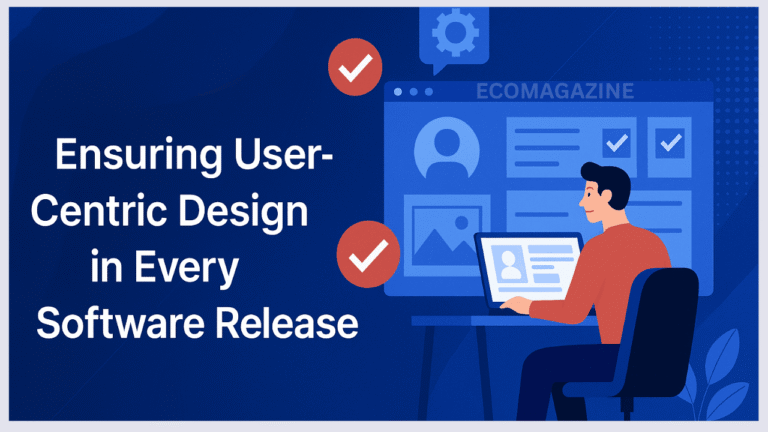Every software release has one clear measure of success: how well it serves the user. Features, performance, and security matter, but if the end product feels complicated or frustrating, adoption suffers. Today’s competitive landscape requires more than just technical innovation, it demands solutions built around real user needs. Companies leading the way, such as Blacksire, understand that user-centric design is no longer optional; it’s the foundation for lasting impact. By focusing on usability, accessibility, and seamless experiences, software teams can deliver products that not only meet expectations but also build loyalty with every update.
Understanding the End User
At the heart of user-centric design lies one essential step: knowing who the users are and what they need. Successful software is shaped by real-world feedback, not just assumptions. Teams gather insights through surveys, interviews, and beta programs to uncover pain points and preferences. This input guides everything from interface layout to feature priority, ensuring that every decision reflects actual user expectations rather than internal guesses.
Balancing Functionality with Simplicity
More features do not always equal better software. Users value tools that are powerful but easy to use. Overloading a product with unnecessary functions often creates confusion and slows adoption. A user-first approach trims away the excess, leaving only what genuinely improves the experience. Clear navigation, intuitive workflows, and a clean interface all help keep complexity under control while still delivering strong functionality.
Integrating User-Centric Design into Development Cycles
From Concept to Prototype
A user-focused release doesn’t start at launch; it begins during planning. Before a single line of code is written, teams map out wireframes and prototypes designed with usability in mind. This allows both designers and potential users to see how features will function in practice. Early involvement creates clarity, reduces costly rework, and sets the tone for a product that prioritizes real-world application over internal assumptions.
Iterative Testing and Continuous Feedback
User-centric design thrives on iteration. Instead of waiting until the final build, successful teams test at every stage of development. Short feedback loops ensure that users have a say in shaping the product as it evolves. This approach helps uncover issues quickly, fine-tunes navigation, and validates whether features deliver value. By making adjustments in real time, teams release software that feels polished and aligned with user expectations.
Tools and Strategies for a User-First Approach
Data-Driven Design Decisions
User behavior leaves a clear trail of insights. Analytics reveal how people interact with features, where they drop off, and what keeps them engaged. Heatmaps, click tracking, and session recordings allow teams to pinpoint friction points. By translating this data into design improvements, developers can refine products to better match user habits. The goal isn’t just to collect numbers but to turn them into actions that directly enhance usability.
Accessibility and Inclusivity
A true user-first mindset ensures that no one is left out. Accessible design makes software usable for individuals with visual, auditory, or cognitive challenges. Features like screen reader compatibility, flexible text sizing, and intuitive color contrast are more than technical adjustments, they’re commitments to inclusivity. Beyond compliance, inclusive design broadens a product’s reach and strengthens its reputation as software that works for everyone.
How Blacksire Software Development Prioritizes User-Centricity
Building for Scalability and Flexibility
User needs rarely stay the same over time. What works today may fall short tomorrow as expectations shift and industries evolve. Blacksire software development emphasizes scalability in every release, ensuring products can grow alongside users. Flexible architecture allows for quick updates, seamless integrations, and the ability to adapt to new demands without sacrificing performance. This future-ready mindset keeps software relevant long after launch.
Industry Best Practices in Action
Blacksire’s approach reflects proven best practices across the software industry. Each project is built with a focus on clarity, reliability, and ease of use. Design decisions are guided by client goals and user expectations, striking a balance between innovation and practicality. By combining strong technical frameworks with an obsession for usability, Blacksire consistently delivers products that not only function well but also feel natural to use. This alignment of business value and user satisfaction is what sets their development process apart.
The Business Value of User-Centric Software Releases
Enhancing Customer Loyalty
When software feels intuitive, users are more likely to stick with it. A smooth, frustration-free experience builds trust and encourages repeat usage. Companies that consistently release user-friendly products see higher customer satisfaction scores and stronger retention rates. Loyalty grows naturally when people feel the product was designed with their needs in mind.
Reducing Development Costs
User-centric design also makes financial sense. By addressing usability early in the process, teams can prevent costly redesigns and support issues later. Each improvement based on feedback reduces the risk of releasing features that go unused or create confusion. Over time, this proactive approach lowers maintenance costs and shortens the development cycle.
Strengthening Brand Reputation
In today’s market, reputation is built on reliability. Users quickly share their experiences online, and positive word-of-mouth can make a product stand out. Companies that prioritize user-focused releases are seen as trustworthy and forward-thinking. Software that works seamlessly not only attracts new customers but also positions the brand as a leader in quality and innovation.
Challenges in Maintaining User-Centric Design
Feature Creep
One of the biggest threats to user-centric design is feature creep which is the tendency to add more functions than users actually need. While extra features may seem appealing, they often clutter the interface and dilute the user experience. Staying focused on what truly matters requires discipline and a clear vision of user priorities.
Rushed Releases
Tight deadlines sometimes push teams to cut corners on testing and feedback. Skipping usability checks can result in a product that looks complete on paper but feels unfinished in practice. Ensuring enough time for proper evaluation helps safeguard against disappointing launches.
Ignoring User Feedback
No amount of planning can replace real input from users. When feedback is overlooked, software risks falling short of expectations. Companies that prioritize listening and acting on user suggestions maintain stronger engagement and deliver more relevant updates.
Future of User-Centric Design in Software Development
Evolving User Expectations
Technology adoption is moving faster than ever, and with it comes rising user expectations. People now demand seamless experiences across devices, instant performance, and personalization that feels natural. Software teams must anticipate these shifts to remain competitive.
AI and Predictive Design
Artificial intelligence is set to play a larger role in shaping user-centric products. Predictive analytics can anticipate user needs, automate adjustments, and deliver tailored experiences. From adaptive interfaces to personalized workflows, AI will help developers design smarter and more responsive software.
Blacksire’s Forward-Looking Vision
Blacksire software development embraces these trends by building adaptable systems ready for future demands. Their approach blends data-driven insights with human-centered design, ensuring each release remains relevant in a constantly changing landscape. This balance of innovation and usability positions them to lead in the next wave of software development.
Conclusion
User-centric design isn’t just a design philosophy, it’s a competitive advantage. Every software release represents an opportunity to connect with users, earn their trust, and build lasting loyalty. By focusing on usability, accessibility, and real-world feedback, businesses can deliver products that work seamlessly and stand out in the market.
Blacksire software development continues to prove that putting users first leads to better adoption, lower costs, and stronger reputations. Each release reflects a commitment to innovation without losing sight of what matters most: the people using the software.
For organizations ready to create software that truly resonates with their audience, the next step is clear. Reach out to the team at [email protected] to learn how user-centric development can transform your next project.


